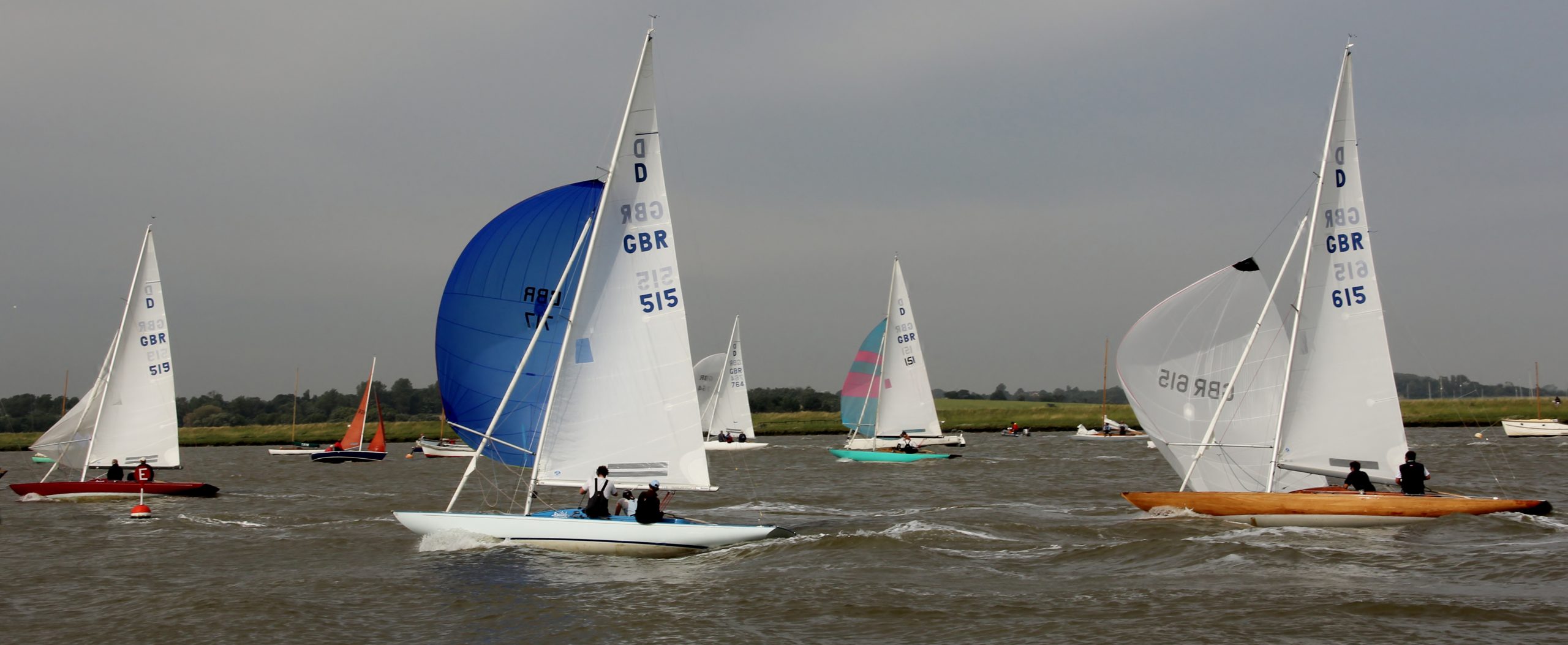Whilst racing on the Clyde members of the Royal North of Ireland Yacht Club were impressed by a new class of yacht being sailed by Mr Daly a Glasgow stockbroker. This boat was a Dragon built by Johanson in Sweden. As a result, Mr Austen Boyd wrote to Johanson on 5th. May 1937 requesting a quote for “six or eight Dragon class boats for delivery in 1938”. The reply confirmed a price of 4,900 Swedish Crowns to include sails, all fittings, measurement certificate and rust-free steel wire. This was then equivalent to a Sterling price of £252.19.4d plus fees payable to the construction supervisor of Gothenburg Kungl Segel Sallskap, (Gothenburg Royal Yacht Club), Capt. Simpson, insurance, freight, duty and harbour dues making a total of £295.2.0d.
On 19th of May McGruer & Co quoted a revised price complete with sails of £287.
On 25th of May a cable was sent to Johanson accepting the quotation of 4,900 Swedish crowns and ordering thirteen Dragons for delivery during March and April 1938.
A copy of the rules for the new Dragon Class introduced in 1929 and accepted by the GKSS, KDY and KNS was obtained on 26th. of May 1937. This included details of the rig and construction also the crew restricted to three, all amateurs. A schedule of material was also obtained. (copy attached or inserted?)
A following letter to Johanson on 7th. of June confirmed a draft of 21,229 Swedish Kr. being one third of the total cost of 13 Dragons had been posted. The following points were also detailed. The boats to be exactly as Mr Daly’s boat. Thirteen to be built at 4,900 Crowns each. One third of the cost paid today, the second when planked and remaining third when shipped. All boats to be complete for shipment in March and April or before the end of this September on account of winter gales. In June, an order for an additional Dragon was placed.
Concern was expressed that the stem head should be strengthened to allow for the mooring conditions on Belfast Lough.
A letter from the Clyde Yacht Clubs’ Conference on 11th. June 1937 to the RNIYC suggested using UK sail numbers,” if only to swell the numbers of UK Dragons and impress upon the Y.R.A what a strong class they are and thereby reproach them for their want of interest in anything that costs less than the price of pure gold”.
A letter was sent on 28th June to Captain Simpson of SS Orsa thanking him for agreeing to call on Johanson and report on progress whilst in Gothenburg.
Again, on 28th June, a letter was sent to Mr Gillholm of the G.K.S.S thanking him for making arrangements to supervise the Dragons being built by Johanson.
A draw was held at the yacht club to allocate the fourteen Dragons, to their respective owners.
Mr Gillholm of the GKSS reported on 17th. of September that five keels had been mounted with keel board moulds and floorings and two boats partly planked, with the masts, booms, rigging, floorboards, boxes, cleats and bulkheads complete for all boats.
A letter was received from The Clyde Yacht Clubs’ Conference confirming that the Dragon rules issued by Scandinavia were very complete and that the Y.R.A now had the authority to issue certificates.
In October Captain Simpson confirmed following a visit to the yard that the first boat was finished except for painting. He also advised that if one or two could be stowed aft he thought they could be shipped during the winter months with very little risk.
He later confirmed on 27th. November that two Dragons had been shipped on SS Orsa and that the first three measurement certificates had been posted by the GKSS. Photograph of Dragon under construction. (copy attached or inserted?)
A letter dated 19th of November from the Convenor of the Dragon Class Committee explained that the writer had met the Dragon Designer Mr Anker in London in an effort to persuade the I.Y.R.U to accept the Dragon as the fifth Olympic class for 1940 games, originally planned for Tokyo then relocated to Helsinki before finally being cancelled.
The Dragon was later accepted as an Olympic class and Ceres ll from the RNIYC did have the distinction of representing GB in Torbay for the 1948 London Games.
On 1st December Johanson advised that the first two were on the way to Belfast. These were received with some damage to paintwork on the topsides so it was requested that cheap blankets or other material be used to prevent damage in future. Johanson was congratulated on the beautiful workmanship and the finish of these boats.
Johanson agreed that topside covers would be provided, he also expressed thanks for the bottles of “midesins”, delivered by Captain Simpson (Old Bushmills whiskey?).
Johanson reported that Fafner had been damaged by the stevedores loading her before he had arrived to supervise the operation.
A request was made to Johanson for the cost of a Dragon half model. May 18th. Johanson confirmed the last two Dragons had been shipped, and that a Dragon model would follow with Capt. Simpson.
Final payment for each boat was requested and received from their new owners by June 1938.
A final payment of 21,229 Kr was confirmed on 7th. of June to Svenska Handelsbank Gothenburg for the account of H.J. Johanson.
A letter was received from a German owner on the 8th. of June thanking the RNIYC for their kind invitation and continued “I have definitely made up my mind to come with my Dragon to Belfast and have written to the owners of other German boats to try to induce them to come along.” A short note eight days later included “unfortunately it would not be possible to come to Belfast”.
Mr Daly wrote to Mr Boyd on 14th of June advising him that “the hotel you have been allotted for the Clyde Regatta is a temperance one, but Kirn boasts a very fine licensed grocer!”
A quotation was received from Ratsey & Lapthorn dated 8th of September, mainsails were priced at £13.10.0d and foresails at £5.8.0d.
Notice of a meeting to be held at The Royal Thames Yacht Club on 23rd of November was received this was to enable Dragon owners to raise any points with The Clyde Yacht Clubs’ Conference as the governing body of the Dragon class.
Minutes of the meeting included; Dragons in Britain had increased from 40 in 1937 to 80 at present. A request had been made to the Dragon committee in Scandinavia asking that the official moulds for the measurers in each country should be made by Mr Anker himself. Spinnakers had been carried by the Solent class last season and provisionally agreed by the Clyde class for 1939. It was agreed that if Scandinavia decided to introduce spinnakers it was important to ensure that those used all over the world were the same. A proposal from the Solent that one professional might be carried was not adopted.
19th December, a letter to Johanson expressed thanks for the beautiful workmanship of the model now received and included “We have had a great year racing and are looking forward to next season”.
Comment was made on the steady improvement in Johanson’s English since the start of the correspondence. More than 48 letters and cables having been exchanged between May 1937 and December 1938.
A letter was received from The Clyde Yacht Clubs’ Conference confirming that they would follow the plans issued by Scandinavia, which would be subject to two modifications before being issued.
In July 1941 letters were received from X.D.O. Forth and from R.A.F. Swanton Morley expressing thanks for the trouble taken in putting their Dragons into safe storage.
Dragon racing resumed on Belfast Lough in 1946 with 13 of the original 14 taking part. For the 1948 season the fleet had increased to 22 with the addition of DK 79 and a batch of new boats DK 197/8/9 200/1/2/3 from Camper and Nicholson. It has been suggested that the Island Sailing Club took one of the batch ordered DK 192 Bluebottle, as a wedding present for the Queen and Prince Philip.
Minutes of the meeting of Dragon Fleet representatives held in Victoria Street SW on 28th May 1947, confirmed the class had been handed over to the National Authority without any countrywide system of measurers. McGruer was to be asked to supply a set of templates to be measured by the Y.R.A. The current translation was deemed inadequate the phraseology to be revised and submitted to the permanent Dragon Committee.
-Pat Hobbs 30.09.2017
(I have to thank Robert and Kenneth Boyd for making their father’s file of DRAGON correspondence, quotations, minutes and notes available which has enabled me to produce the following account – PH).

